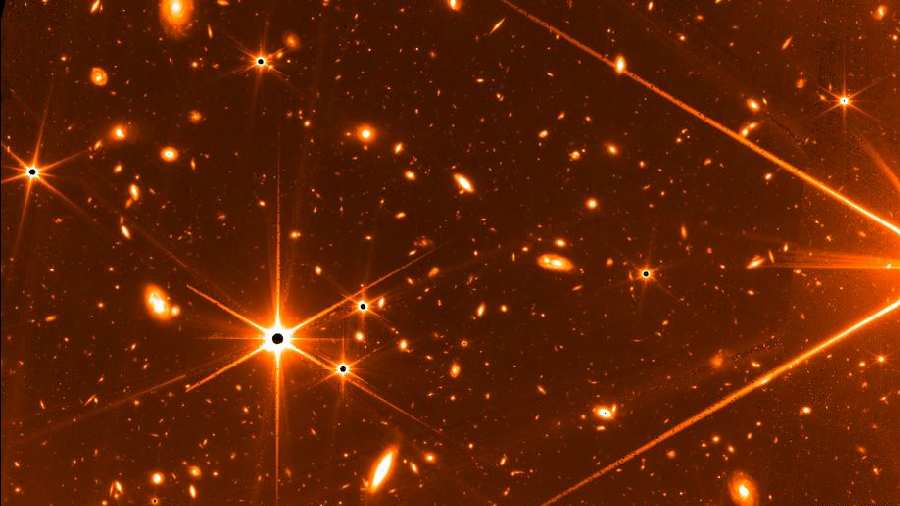It has never been detected, only speculated. But scientists estimate that up to 85% of the matter in the universe could be made of what's called dark matter.
Scientists cannot define dark matter with any certainty, but that hasn't stopped the search for it. Our largest and newest space-based telescope, the James Webb Space Telescope is on the case.
It was barely moments after the first images taken by the telescope had been released on July 12, 2022, when Kai Noeske said something both mysterious and true.
Noeske, an astronomer at the European Space Observation Centre (ESOC) in Darmstadt, Germany, was pointing to an image of Stephan's Quintet, a group of five galaxies, as they have never been seen before.
![Astronomer Kai Noeske looked at the image of Stephan's Quintet and said, 'There is a lot out there that we do not know [...] One of those things could be dark matter'](https://assets.telegraphindia.com/telegraph/2022/Aug/1660115219_new-project-12.jpg)
Astronomer Kai Noeske looked at the image of Stephan's Quintet and said, 'There is a lot out there that we do not know [...] One of those things could be dark matter' Deutsche Welle
And he said, "There is a lot out there that we do not know. And we do not know what we do not know. [But] one of those things could be dark matter."
An accidental discovery
In the 19th century, Lord Kelvin, a Scottish-Irish physicist, wanted to estimate the mass of our galaxy, the Milkyway, using data on how fast stars moved around the galaxy's core.
But Kelvin found discrepancies or anomalies in the data, things which could not be explained and were attributed to "dark bodies" that we cannot see.
"The galaxy seems to be rotating much faster than it should, based on estimates," explained Tevong You, a theorist at CERN, the European Organization for Nuclear Research.

The Large Hadron Collider is the world's most powerful particle accelerator Deutsche Welle
The theory is that there is an "invisible matter" responsible for the speed at which our galaxy rotates, said You. And that may be true of other galaxies as well.
Stars have been observed to travel at higher-than-estimated speeds, especially at the edges of galaxies. And that is weird.
Stars should cut loose and 'fly off'
Imagine you attached a stone to a string, and you rotated it at high speed. The stone would cut loose and fly off if it reached a speed higher than a certain threshold — a point at which the string becomes too weak to hold onto the stone, as the stone picks up speed and gains more force.
But astronomers have observed stars that continue to spin around the center of the galaxy, even when the string holding them to the galaxy, as it were, should have ripped, and the stars should have "flown off".
The astronomers' only explanation is that there must be some invisible matter holding the stone in range. Perhaps it's this elusive dark matter?
That remains an unanswered question. And there are many other anomalies, such as the shape of some galaxies, including our Milkyway, that are so far unexplained.
We can't see dark matter but we may see its effects
Scientists say that the reason we are unable to see or detect this invisible matter is that it does not interact with electromagnetic forces — things like visible light, X-ray or radio waves.
They argue that we can, however, observe some of the effects of dark matter through its gravitational force.
But we still want to detect dark matter in its own right. And here's where CERN's Large Hadron Collider comes in. Tevong You and other researchers at CERN think the LHC is our best chance of detecting dark matter.

When particles collide at the LHC, the resulting debris gets caught in detectors such as this one. This is a illustrating one of the LHC's detectors Deutsche Welle
A decade ago, experiments at the LHC proved the Standard Model of particle physics by detecting the Higgs boson particle — a particle which itself had long proved to be elusive.
The Standard Model is the idea that everything in the universe is made of a few fundamental particles and that those are governed by four fundamental forces — the strong force, the weak force, the electromagnetic force, and the gravitational force.
Tevong You said that the LHC could help solve the mystery of dark matter. But even now, You suspects that dark matter will be nothing like the particles we know from the Standard Model.
"It has to interact very weakly. It can't interact with light or electromagnetism. It can't interact with the strong force, and it may interact through the weak force that causes radioactivity," said You.
If that reads like a riddle, you're not alone. Scientists are still trying to work it out themselves.
Measuring dark matter by what's missing
The Large Hadron Collider smashes particles together to create collisions. The collisions produce a debris that gets caught by particle detectors.
It's just the same as if you smashed two apples together, bits would spray in all directions and get caught on the walls and floor. Those bits of apple would still be fruit, but they would have also become somewhat different. Even so, if we then collected all the bits of apple, including the juices, we would theoretically have all the bits to reconstruct those two original apples.
And the same is true of fundamental particles. We smash them up, they split and spray against the LHC detectors, and if we piece them back together, we should be able to account for all the bits that made those original particles.
But if after all that, we find that there is something missing... especially missing energy or mass, as energy is also known... Well, when it comes to particle physics, scientists tend to think that there would have to be some dark, or invisible, matter — elements that we can't see, but which are very much part of the whole thing.
Andre David is an experimental physicist at CERN who builds particle detectors and says that if there is missing energy after a collision, it is likely that that energy has been transferred to dark matter.
"The Higgs boson interacts with all the other elements that have mass. And so dark matter must [also] have mass in order to fulfill the effect that we see in the galaxies," said David.
New theories about dark matter
Some scientists argue that if there were invisible forces in the universe, we would have found them already and that, given that we haven't detected those forces, they suggest we should think outside of the Standard Model.
One of those scientists is the physicist Mordehai Milgrom. Milgrom has developed an alternative theory of gravity, one that suggests that gravitational force operates differently at different distances from the core of a galaxy.
While Newton's theory of gravity explains most large-scale movements in the cosmos, Milgrom's Modified Newtonian Dynamics suggests that a force acts differently when it is weak, such as at the edge of a galaxy.
Advocates of the theory say it predicts the rotation of galaxies and the speed of the stars better than Newton's theory.
But we still don't know whether we will ever discover dark matter or prove Milgrom's Modified Newtonian Dynamics. What we do know is that our understanding of the universe is far from complete.












